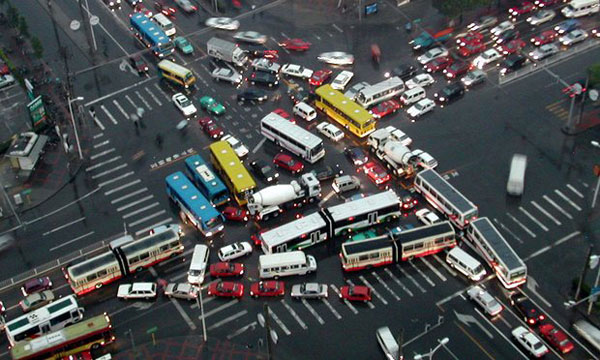当前位置: Language Tips> 双语新闻
Beijing has fallen: China's capital sinking by 11cm a year, satellite study warns

China’s capital is known for its horrendous smog and occasional sandstorms. Yet one of its major environmental threats lies underground: Beijing is sinking.
北京可怕的雾霾和偶尔发生的沙尘暴为世人皆知,而一个重要的环境威胁却被大家忽略了:北京正在下沉。
Excessive pumping of groundwater is causing the geology under the city to collapse, according to a new study using satellite imagery that reveals parts of Beijing – particularly its central business district – are subsiding each year by as much as 11 centimetres, or more than four inches.
一项根据卫星图像作出的最新研究结果显示,过度抽取地下水导致北京地下结构出现塌陷。北京部分地区,特别是中央商务区,每年下沉多达11厘米,也就是超过4英寸。
The authors of the study warn that continued subsidence poses a safety threat to the city of more than 2o million, with “a strong impact on train operations” one of the predictions.
研究报告的作者提醒说,持续的下沉对这座人口超过两千万的城市构成安全威胁,其中一个预测就是“将对铁路运营造成很大影响”。
The study on Beijing’s subsidence has been published in the peer-reviewed journal Remote Sensing and is based on InSAR, a type of radar that monitors land elevation changes. It was written by a team of seven researchers.
这项有关北京下沉的研究发表在同行评议期刊《遥感科学》上,基于合成孔径雷达干涉测量技术,这是一种监测陆地高程变化的雷达技术。研究小组有7人。
“We are currently carrying out a detailed analysis of the impacts of subsidence on critical infrastructure (eg high-speed railways) in the Beijing plain,” they said in an email to the Guardian. “Hopefully a paper summarising our findings will come out later this year.”
他们在给《卫报》的一封电邮中写道:“我们目前正在进行一项北京平原地区地表下沉对关键基础设施影响的详细分析(比如高铁)。希望能在今年晚些时候发表一份能概括我们研究结果的论文。”
Beijing sits in a dry plain where groundwater has accumulated over millennia. As wells are drilled and the water table drops, the underlying soil compacts, much like a dried-out sponge.
北京坐落于干燥的平原地区,地下水经过了数千年的累积。随着钻井抽取地下水,地下水位下降,地下的土壤更加紧密,就像干涸的海绵。
The study finds that the entire city is sinking but the subsidence is most pronounced in Beijing’s Chaoyang district, which has boomed since 1990 with skyscrapers, ringroads and other development. The researchers say the uneven nature of the subsidence in some areas poses risks to buildings and other infrastructure.
研究发现,整个城市都在下沉,而朝阳区下沉最严重。上世纪90年代以来,朝阳区繁荣发展,高楼大厦和环路不断涌现。研究人员说,一些地区下沉不均匀的特性会对建筑物和其他基础设置造成威胁。
Tens of thousands of water wells are thought to exist in and around Beijing, many of them used in farming and landscaping. The state has regulatory power over installation of wells but is inconsistent in applying it, according to one leading Chinese environmentalist.
据称北京及周边地区有数万口水井,其中很多用于农田灌溉和绿化。国家对打井有监管权,但据一位领头的环保人士说,实际执行情况并不理想。
“There are some rules but the enforcement is doubtful,” said Ma Jun, director of the Institute of Public and Environmental Affairs in Beijing. Ma said he wasn’t surprised subsidence was relatively high in the Chaoyang district given its rapid growth of recent decades. He expected it to keep moving east as the city sprawled in that direction.
公众环境研究中心主任马俊说:“有一些监管规则,但执行成效令人怀疑。”马俊说他对朝阳区地表下沉速度更快并不惊讶。因为朝阳区近几十年来发展非常快。他预计随着整个城市向东扩展,地表下沉将会继续向东延伸。
China inaugurated a mega-engineering project aimed at mitigating Beijing’s water crisis. The state completed construction of the South-North Water Diversion.
中国实施了一项大型的工程项目来缓解北京的用水紧张,现已完成了南水北调工程的建设。
Even before the canal began delivering water, Beijing was easing up on some groundwater pumping. In January of 2015 the Chaoyang district announced plans to phase out 367 water wells, reducing the use of 10m cubic meters of underground water.
在南水北调工程开始通水之前,北京已经开始控制某些地区的地下水抽取。2015年1月,朝阳区宣布计划停用367口水井,每年减少开采地下水千余万立方米。
Experts say it is still too early to know if the canal’s water deliveries will help recharge the aquifer and slow Beijing’s rate of subsidence. In the meantime concerns about impacts to buildings and rail systems continue. To prevent derailments a 2015 study recommended that China ban new water wells near completed high-speed rail lines.
专家表示,想要知道南水北调能否帮助充盈含水层并减慢北京下沉的速度还为时尚早。在此期间,人们仍将担心下沉对建筑物和铁路系统的影响。为防止列车脱轨,2015年的一项研究建议中国禁止在已完工的高铁轨道旁打井。
Other cities around the world are experiencing subsidence caused by excessive water pumping or other factors. Mexico City is sinking by up to 28cm a year and Jakarta is subsiding at a similar rate. Bangkok is dropping annually by as much as 12cm, similar to Beijing, according to the Remote Sensing researchers.
根据《遥感科学》的研究,世界上其他诸多城市也受到过度抽取地下水或其他因素导致的地表下沉的困扰。墨西哥城每年下沉多达28厘米,雅加达下沉速度类似。曼谷每年下沉多达12厘米,与北京类似。
英文来源:英国卫报
翻译&编辑:yaning
上一篇 : 开会那些事儿:如何假装很忙
下一篇 : 时尚新宠:菠萝叶做成的皮革
关注和订阅


电话:8610-84883645
传真:8610-84883500
Email: languagetips@chinadaily.com.cn